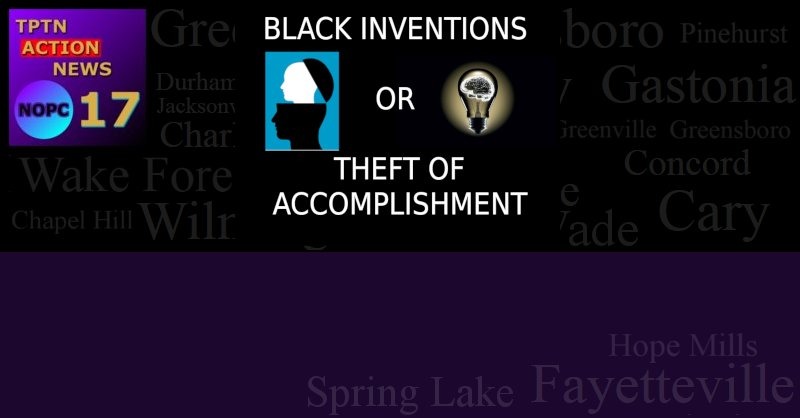Were They Really Black Inventions?
BLACK INVENTIONS?
Traffic Signal
Invented by Garrett A. Morgan in 1923? Nope.

The first known traffic signal appeared in London in 1868 near the Houses of Parliament. Designed by JP Knight, it featured two semaphore arms and two gas lamps. The earliest electric traffic lights include Lester Wire’s two-color version set up in Salt Lake City circa 1912, James Hoge’s system (US patent #1,251,666) installed in Cleveland by the American Traffic Signal Company in 1914, and William Potts’ 4-way red-yellow-green lights introduced in Detroit beginning in 1920. New York City traffic towers began flashing three-color signals also in 1920.
- Garrett Morgan in 1914? Nope.
 The invention of the gas mask predates Morgan’s breathing device by several decades. Early versions were constructed by the Scottish chemist John Stenhouse in 1854 and the physicist John Tyndall in the 1870s, among many other inventors prior to World War I.
The invention of the gas mask predates Morgan’s breathing device by several decades. Early versions were constructed by the Scottish chemist John Stenhouse in 1854 and the physicist John Tyndall in the 1870s, among many other inventors prior to World War I.- George Washington Carver (who began his peanut research in 1903)? Nope.
 Peanuts, which are native to the New World tropics, were mashed into paste by Aztecs hundreds of years ago. Evidence of modern peanut butter comes from US patent #306727 issued to Marcellus Gilmore Edson of Montreal, Quebec in 1884, for a process of milling roasted peanuts between heated surfaces until the peanuts reached “a fluid or semi-fluid state.” As the product cooled, it set into what Edson described as “a consistency like that of butter, lard, or ointment.” In 1890, George A. Bayle Jr., owner of a food business in St. Louis, manufactured peanut butter and sold it out of barrels. J.H. Kellogg, of cereal fame, secured US patent #580787 in 1897 for his “Process of Preparing Nutmeal,” which produced a “pasty adhesive substance” that Kellogg called “nut-butter.”
Peanuts, which are native to the New World tropics, were mashed into paste by Aztecs hundreds of years ago. Evidence of modern peanut butter comes from US patent #306727 issued to Marcellus Gilmore Edson of Montreal, Quebec in 1884, for a process of milling roasted peanuts between heated surfaces until the peanuts reached “a fluid or semi-fluid state.” As the product cooled, it set into what Edson described as “a consistency like that of butter, lard, or ointment.” In 1890, George A. Bayle Jr., owner of a food business in St. Louis, manufactured peanut butter and sold it out of barrels. J.H. Kellogg, of cereal fame, secured US patent #580787 in 1897 for his “Process of Preparing Nutmeal,” which produced a “pasty adhesive substance” that Kellogg called “nut-butter.”Peanut Products in General
George Washington Carver
- “Discovered” hundreds of new and important uses for the peanut? Fathered the peanut industry? Revolutionized southern US agriculture? Nope.
- Most of Carver’s peanut and sweet potato creations were either unoriginal, impractical, or of uncertain effectiveness. No product born in his laboratory was widely adopted.
- The boom years for Southern peanut production came prior to, and not as a result of, Carver’s promotion of the crop.
- Carver’s work to improve regional farming practices was not of pioneering scientific importance and had little demonstrable impact.
- Elijah McCoy revolutionized industry in 1872 by inventing the first device to automatically oil machinery? Nope.
- The phrase “Real McCoy” arose to distinguish Elijah’s inventions from cheap imitations? Nope.
- Dr. Charles Drew in 1940? Nope.
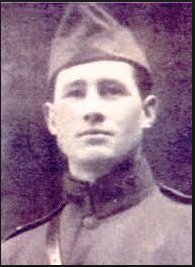
During World War I, Dr. Oswald H. Robertson of the US army preserved blood in a citrate-glucose solution and stored it in cooled containers for later transfusion. This was the first use of “banked” blood. By the mid-1930s the Russians had set up a national network of facilities for the collection, typing, and storage of blood. Bernard Fantus, influenced by the Russian program, established the first hospital blood bank in the United States at Chicago’s Cook County Hospital in 1937. It was Fantus who coined the term “blood bank.”
- Did Charles Drew “discover” (in about 1940) that plasma could be separated and stored apart from the rest of the blood, thereby revolutionizing transfusion medicine? Nope.

The possibility of using blood plasma for transfusion purposes was known at least since 1918, when English physician Gordon R. Ward suggested it in a medical journal. In the mid-1930s, John Elliott advanced the idea, emphasizing plasma’s advantages in shelf life and donor-recipient compatibility, and in 1939 he and two colleagues reported having used stored plasma in 191 transfusions. Charles Drew was not responsible for any breakthrough scientific or medical discovery; his main career achievement lay in supervising or co-supervising major programs for the collection and shipment of blood and plasma.
- Benjamin Banneker? Nope.
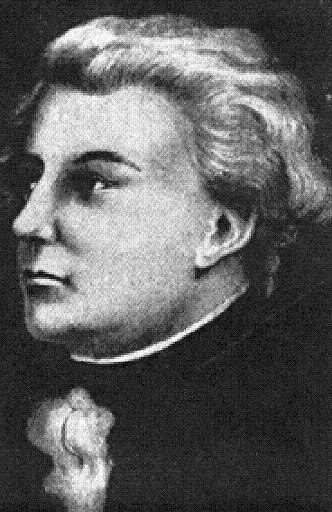
Pierre-Charles L’Enfant created the layout of Washington DC. Banneker assisted Andrew Ellicott in the survey of the federal territory, but played no direct role in the actual planning of the city. The story of Banneker reconstructing the city design from memory after L’Enfant ran away with the plans (with the implication that the project would have failed if not for Banneker) has been debunked by historians.
- Lewis Latimer invented the carbon filament in 1881 or 1882? Nope.

English chemist/physicist Joseph Swan experimented with a carbon-filament incandescent light all the way back in 1860, and by 1878 had developed a better design which he patented in Britain. On the other side of the Atlantic, Thomas Edison developed a successful carbon-filament bulb, receiving a patent for it (#223898) in January 1880, before Lewis Latimer did any work in electric lighting. From 1880 onward, countless patents were issued for innovations in filament design and manufacture (Edison had over 50 of them). Neither of Latimer’s two filament-related patents in 1881 and 1882 were among them, nor did they make the light bulb last longer, nor is there reason to believe they were adopted outside Hiram Maxim’s company where Latimer worked at the time. (He was not hired by Edison’s company until 1884, primarily as a draftsman and an expert witness in patent litigations).
- Dr. Daniel Hale Williams in 1893? Nope.

Dr. Williams repaired a wound not in the heart muscle itself, but in the sac surrounding it, the pericardium. This operation was not the first of its type: Henry Dalton of St. Louis performed a nearly identical operation two years earlier, with the patient fully recovering. Decades before that, the Spaniard Francisco Romero carried out the first successful pericardial surgery of any type, incising the pericardium to drain fluid compressing the heart.
- Granville Woods in 1901? Nope.

Werner von Siemens pioneered the use of an electrified third rail as a means for powering railway vehicles when he demonstrated an experimental electric train at the 1879 Berlin Industrial Exhibition. In the US, English-born Leo Daft used a third-rail system to electrify the Baltimore & Hampden lines in 1885. The first electrically powered subway trains, which debuted in London in the autumn of 1890, likewise drew power from a third rail.
- Granville Woods prevented railway accidents and saved countless lives by inventing the train telegraph (patented in 1887), which allowed communication to and from moving trains? Nope.
- Frederick Jones (with Joseph Numero) in 1938? Nope.
- Did Jones change America’s eating habits by making possible the long-distance shipment of perishable foods? Nope.
- Granville Woods in 1904? Nope.
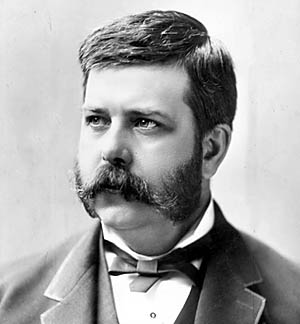
In 1869, a 22-year-old George Westinghouse received US patent #88929 for a brake device operated by compressed air, and in the same year organized the Westinghouse Air Brake Company. Many of the 361 patents he accumulated during his career were for air brake variations and improvements, including his first “automatic” version in 1872 (US #124404).
- Frederick Jones in 1949? Nope.

Dr. Willis Carrier built the first machine to control both the temperature and humidity of indoor air. He received the first of many patents in 1906 (US patent #808897, for the “Apparatus for Treating Air”). In 1911 he published the formulae that became the scientific basis for air conditioning design, and four years later formed the Carrier Engineering Corporation to develop and manufacture AC systems.
- J.F. Pickering in 1900? Nope.
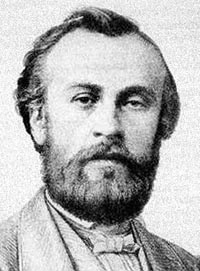
French engineer Henri Giffard successfully flew a powered navigable airship in 1852. The La France airship built by Charles Renard and Arthur Krebs in 1884 featured an electric motor and improved steering capabilities. In 1900 Count Ferdinand von Zeppelin’s first rigid-framed dirigible took to the air. Of the hundreds of inventors granted patents for early airship designs and modifications, few succeeded in building or flying their craft. There doesn’t appear to be any record of a “Pickering Airship” ever getting off the ground.
- Andrew Beard invented the “Jenny [sic] coupler” in 1897? Nope.
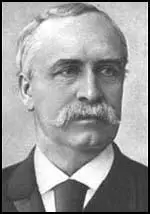
The Janney coupler is named for US Civil War veteran Eli H. Janney, who in 1873 invented a device (US patent #138405) which automatically linked together two railroad cars upon their being brought into contact. Also known as the “knuckle coupler,” Janney’s invention superseded the dangerous link-and-pin coupler and became the basis for standard coupler design through the remainder of the millennium. Andrew Beard’s modified knuckle coupler was just one of approximately eight thousand coupler variations patented by 1900.
- Richard Spikes in 1932? Nope.

The first automatic-transmission automobile to enter the market was designed by the Sturtevant brothers of Massachusetts in 1904. US Patent #766551 was the first of several patents on their gearshift mechanism. Automatic transmission technology continued to develop, spawning hundreds of patents and numerous experimental units; but because of cost, reliability issues and an initial lack of demand, several decades passed before vehicles with automatic transmission became common on the roads.
- Isaac R. Johnson in 1899? Nope.
- Henry T. Sampson in 1971? Nope.
- Benjamin Banneker built the first American timepiece in 1753? Nope.
Several watch and clockmakers were already established in the colony [Maryland] prior to the time that Banneker made the clock. In Annapolis alone there were at least four such craftsmen prior to 1750. Among these may be mentioned John Batterson, a watchmaker who moved to Annapolis in 1723; James Newberry, a watch and clockmaker who advertised in the Maryland Gazette on July 20, 1748; John Powell, a watch and clockmaker believed to have been indentured and to have been working in 1745; and Powell’s master, William Roberts.
Silvio Bedini, The Life of Benjamin Banneker (Baltimore: Maryland Historical Society, 1999)
- George T. Sampson in 1892? Nope.
My invention relates to improvements in clothes-driers…. The object of my invention is to suspend clothing in close relation to a stove by means of frames so constructed that they can be readily placed in proper position and put aside when not required for use.US patent #476416, 1892
- Lloyd P. Ray in 1897? Nope.
- Willie Johnson in 1884? Nope.
- Did Granville Woods invent the electric trolley car, the overhead wire that powers it, or the “troller” wheel that makes contact with the trolley wire, in 1888? Nope.
- Alexander Miles in 1887? Nope.
- Was Miles the first to patent a self-closing shaft door? Nope.
- Was Philip Emeagwali responsible for the world’s fastest computer or computation in 1989? Nope.
- Did he win the “Nobel Prize of computing”? Nope.
- Is he a “father of the Internet”? Nope.
- Joseph Winters in 1878? Nope.
In 1784, Daniel Maseres, of England, invented a machine called a fire escape, which, being fastened to the window, would enable anyone to descend to the street without injury.Benjamin Butterworth, Growth of Industrial Art, 1888
- Thomas J. Martin in 1872? Nope.
- Lloyd Hall “is responsible for the meat curing products, seasonings, emulsions, bakery products, antioxidants, protein hydrolysates, and many other products that keep our food fresh and flavorful”? Nope.
- Hall “revolutionized the meatpacking industry”? Nope.
- W.B. Purvis in 1890? Nope.
- Dr. George Grant in 1899? Nope.
- Lyda Newman in 1898? Nope.
- Frederick Mosby? Nope.
- William Purvis in 1883? Nope.
- Alice Parker in 1919? Nope.
- Oscar E. Brown in 1892? Nope.
- Augustus Jackson in 1832? Nope.
- Sarah Boone in 1892? Nope.
- Patricia Bath “transformed eye surgery” by inventing the first laser device to treat cataracts in 1986? Nope.
- John Burr in 1899? Nope.
- J. H. Smith in 1897? Elijah McCoy? Nope.
- P. Downing invented the street letter drop box in 1891? Nope.
- George Becket invented the private mailbox in 1892? Nope.
Mail boxes as we understand them first appeared on the streets of Belgian towns in 1848. In Paris they came two years later, while the English received their ‘pillar boxes’ in 1855.Laurin Zilliacus, Mail for the World, p. 178 (New York, J. Day Co., 1953)
- Thomas W. Stewart in 1893? Nope.
- Charles Brooks in 1893? Nope.
- Was it the first with a hinged receptacle to catch the clippings? Nope.
- John Lee Love in 1897? Nope.
- Marjorie Joyner in 1928? Nope.
- William Barry in 1897? Nope.
- W.A. Lavalette invented “the advanced printing press” in 1878? Nope.
- George Tolivar or Benjamin Montgomery? Nope.
- Thomas Elkins in 1879? John Stanard in 1891? Nope.
- Andrew Beard in 1892? Nope.
- Lewis Latimer? Nope.
Edison’s long-time associates, Edward H. Johnson and John Ott, were principally responsible for designing fixtures in the fall of 1880. Their work resulted in the screw socket and base very much like those widely used today.R. Friedel and P. Israel, Edison’s Electric Light: Biography of an Invention, (New Brunswick, NJ: Rutgers Univ. Press, 1986).
- Onesimus the slave in 1721? Nope.
- Onesimus knew of variolation, an early inoculation technique practiced in several areas of the world before the discovery of vaccination.
- L. Bell in 1871? Nope.
- Granville Woods in 1884? Nope.
- Charles Brooks in 1896? Nope.
- Joseph Gammel/Gamell in 1976? Nope.
- T. Elkins in 1897? Nope.
- Lewis Latimer in 1874? Nope.
- M.A. Cherry in 1886? Nope.
- Richard Spikes in 1913? Nope.
- Did the 1913 Pierce Arrow feature Spikes’ turn signals? Nope.
- L.S. Burridge & N.R. Marshman in 1885? Nope.
A few thoughts…..
Every year during Black History Month, we get to hear about all of the colored geniuses in our midst. We all get this nonsense shoved in our faces in school, on T.V., etc…..We hear that if it weren’t for black people inventing traffic lights, we’d all be crashing at intersections. We have to keep a straight face while they tell us that if blacks hadn’t invented elevators, we’d still be stuck on the first floor. As if white people, intelligent enough to create, design and develop automobiles, paved roads, and an Interstate highway system couldn’t figure out how to avoid running into each other at intersections. Or that anyone smart enough to build skyscrapers could never figure out how to get to the top floor without brilliant negroes inventing elevators.
Even if blacks had actually contributed to society by inventing things, something tells me Western Civilization could have managed without them, somehow. Unfortunately for the delicate feelings of our overly-sensitive colored friends, most of what is taught as fact in our schools and museums about their great achievements are absolutely false. Pure fiction. White people are too afraid of being branded a racist to actually call out these preposterous tales of black ingenuity, so we just figure it helps the poor things feel good about themselves to imagine that they can actually pull their weight in an advanced technological society.
Modern blacks think that it’s lame to do well in school, and they’d rather collect welfare and demand an easy life from white taxpayers. Back in the 1920’s, for example, blacks, for the most part, knew they had better do their best to keep up with us, and they taught their kids that they would have to work twice as hard as white folks to get half as far. Given their obvious intellectual shortcomings, this was a fairly accurate outlook. Also, most of the “blacks” glorified for past achievements are at least half white, judging by the looks of them. Some even passed for white in our society. So with white genes and the advantage of being raised in a white-dominated culture, it’s expected that a certain number of them would attempt to tinker around with our technology and try their hand at inventing things. While they should be given credit for doing their best, and even obtaining patents in some cases, the vast majority of the technical contributions that they made were either not very helpful or were near-replicas of things that had been patented decades earlier by white folks.
If blacks were the geniuses that they would have us believe, where are the African scientists, inventors and innovators? Where is the African space program? If blacks were so intelligent, and the only reason they don’t do well in American society is because we oppress them and deny them opportunities, you would think that in their native lands they would be free to express their intellectual prowess without being bothered by mean white people. Yet we see that, even as little as blacks have contributed to society, they have only done that much in our country, where they have all of the cultural and educational advantages that we can share with them.
Google this stuff up yourself, and you will find that websites, museums and probably your child’s public schools repeat this nonsense. I was reading one Afro-centric website that actually claimed that many black inventors are unknown because they were slaves at the time and not given credit for their technological prowess. Of course, if slave owners were taking credit for their slaves’ inventions, how would black people today know it happened?
Also, even if slaves and newly-freed blacks really created all of this stuff, that kind of screws up all of the excuses blacks make these days for their present-day ignorance, illiteracy and general lack of ability to make it in a modern white civilization, doesn’t it? I mean, how can you tell me that Latrelle or Shaniqua can’t pass their SAT’s because of a history of racism and oppression and then turn around and say that blacks were actually smarter and more creative when we owned them? I’m so tired of hearing them blame slavery for everything. Look, we brought you people here and made you do chores. Long time ago. Get over it. And stop taking credit for inventing things you probably can’t even spell, it just makes you look silly.
Have you ever noticed the dates on the vast majority of these so-called black inventions? Late 1800’s and early 1900’s for the most part. Isn’t that when schools all over America were segregated, as well as neighborhoods and almost every other public place? Isn’t that when blacks were regularly lynched for the crimes they committed? Modern blacks are always moaning about the Jim Crow days and how we oppressed and excluded them, yet, on the other hand, they apparently want to claim that there was some huge surge in black geniuses running around inventing things. How could that be? Seems like these blacks want to have it both ways, because they don’t really understand how things work. And if all of these alleged black inventors could achieve these great things in the face of segregation laws and oppression, why couldn’t all of the other blacks do the same back then? No, they screamed and rioted and claimed segregation was keeping them down, so we opened our entire society up to them thinking they would shut up for a while and leave us alone, but nope, somehow we are still keeping them down.
As negligible and trivial as the accomplishments of these black “inventors” were, at least they were trying. They understood that to get ahead, you had to imitate the white race as best you could. That was back when we actually ran things. Now you have Blacks running around trying to control their schools and neighborhoods and consequently they are at their highest levels of illiteracy, illegitimacy and criminality since we found them eating their grandmothers in Africa centuries ago.
As hard as it may be for American blacks to admit this, they only achieve their highest potential in orderly, civilized societies. In other words, strong white societies. They have shown that their “talented tenth,” as W.E.B. DuBois called them, can only thrive in conditions and environments that they could never create or maintain themselves.

